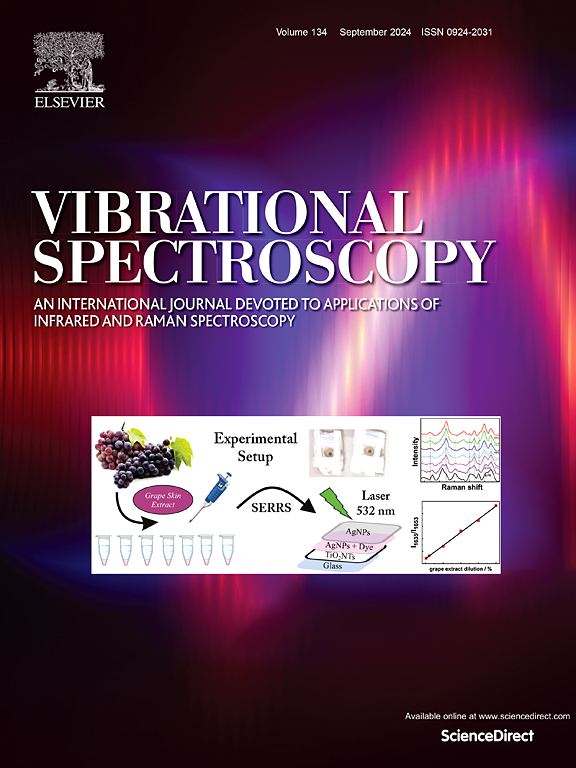FT-IR study on ambers produced from the Tohoku and Hokkaido regions in Japan
IF 3.1
3区 化学
Q2 CHEMISTRY, ANALYTICAL
引用次数: 0
Abstract
We performed a series of Fourier Transform infrared (FT-IR) studies on Late Cretaceous Kuji and Iwaki ambers from the Tohoku region, Late Cretaceous Pombetsu and Manji ambers and Eocene Sunago ambers from Mikasa area in the Hokkaido region, and Eocene ambers from Fushun in China. Based on spectral features and principal component scores, these FT-IR spectra could be successfully classified into three groups: Kuji and Iwaki ambers, Pombetsu and Manji ambers, and Sunago and Fushun ambers, respectively. This grouping reflects the fact that amber-forming forests are the same or closely related species within the group, but different among the groups. Geological surveys on the Upper Cretaceous Yezo Group around the Mikasa area indicate that the Pombetsu ambers were reburied in terrestrial environments about 4 million years earlier than the Manji ambers buried in shallow marine deposits. The Late Cretaceous ambers from the Mikasa Formation frequently contain various concentrations of calcite, and their FT-IR spectra are quite different from the Kuji and Iwaki ambers which are free from calcite. These observations strongly suggest different amber-forming environments between the Tohoku and Hokkaido regions in the Late Cretaceous. In contrast, high similarities of FT-IR spectra between Sunago and Fushun ambers suggest the same or similar amber-forming environments in the Eocene near the eastern end of the Eurasian plate. Although the current geographical distance between Sunago and Fushun is about 1500 km, the distance was much closer in the Eocene before the establishment of the Sea of Japan.
日本东北和北海道地区产琥珀的FT-IR研究
我们对东北地区晚白垩世的Kuji和Iwaki琥珀、北海道地区晚白垩世的Pombetsu和Manji琥珀、北海道地区Mikasa地区始新世的Sunago琥珀以及中国阜顺始新世的琥珀进行了一系列傅里叶变换红外(FT-IR)研究。根据光谱特征和主成分得分,将这些红外光谱成功地划分为三组:久地和岩崎琥珀,Pombetsu和Manji琥珀,Sunago和抚顺琥珀。这种分组反映了一个事实,即形成琥珀的森林在组内是相同或密切相关的物种,但在组之间不同。对Mikasa地区上白垩统Yezo群的地质调查表明,Pombetsu琥珀在陆地环境中重新埋藏的时间比埋在浅海沉积物中的Manji琥珀早约400万年。晚白垩世Mikasa组琥珀中经常含有不同浓度的方解石,其FT-IR光谱与不含方解石的Kuji和Iwaki琥珀有很大不同。这些观测结果有力地说明了晚白垩世东北和北海道地区琥珀形成环境的差异。Sunago琥珀和抚顺琥珀的FT-IR光谱高度相似,表明在欧亚板块东端附近的始新世具有相同或相似的琥珀形成环境。虽然现在Sunago和抚顺之间的地理距离约为1500 公里,但在日本海建立之前的始新世,这一距离要近得多。
本文章由计算机程序翻译,如有差异,请以英文原文为准。
求助全文
约1分钟内获得全文
求助全文
来源期刊

Vibrational Spectroscopy
化学-分析化学
CiteScore
4.70
自引率
4.00%
发文量
103
审稿时长
52 days
期刊介绍:
Vibrational Spectroscopy provides a vehicle for the publication of original research that focuses on vibrational spectroscopy. This covers infrared, near-infrared and Raman spectroscopies and publishes papers dealing with developments in applications, theory, techniques and instrumentation.
The topics covered by the journal include:
Sampling techniques,
Vibrational spectroscopy coupled with separation techniques,
Instrumentation (Fourier transform, conventional and laser based),
Data manipulation,
Spectra-structure correlation and group frequencies.
The application areas covered include:
Analytical chemistry,
Bio-organic and bio-inorganic chemistry,
Organic chemistry,
Inorganic chemistry,
Catalysis,
Environmental science,
Industrial chemistry,
Materials science,
Physical chemistry,
Polymer science,
Process control,
Specialized problem solving.
 求助内容:
求助内容: 应助结果提醒方式:
应助结果提醒方式:


